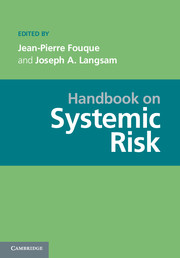Book contents
- Frontmatter
- Contents
- Contributors
- Introduction
- PART I DATA: THE PREREQUISITE FOR MANAGING SYSTEMIC RISK
- 1 Systemic Risk Information Requirements: Current Environment, Needs, and Approaches for Development
- 2 Aligning Models and Data for Systemic Risk Analysis
- 3 Applying FpML
- 4 Data Integration for Systemic Risk in the Financial System
- 5 Semantics in Systemic Risk Management
- PART II STATISTICS AND SYSTEMIC RISK
- PART III MEASURING AND REGULATING SYSTEMIC RISK
- PART IV NETWORKS
- PART V SYSTEMIC RISK ANDMATHEMATICAL FINANCE
- PART VI COUNTERPARTY RISK AND SYSTEMIC RISK
- PART VII ALGORITHMIC TRADING
- PART VIII BEHAVIORAL FINANCE: THE PSYCHOLOGICAL DIMENSION OF SYSTEMIC RISK
- PART IX REGULATION
- PART X COMPUTATIONAL ISSUES AND REQUIREMENTS
- PART XI ACCOUNTING ISSUES
- References
1 - Systemic Risk Information Requirements: Current Environment, Needs, and Approaches for Development
from PART I - DATA: THE PREREQUISITE FOR MANAGING SYSTEMIC RISK
Published online by Cambridge University Press: 05 June 2013
- Frontmatter
- Contents
- Contributors
- Introduction
- PART I DATA: THE PREREQUISITE FOR MANAGING SYSTEMIC RISK
- 1 Systemic Risk Information Requirements: Current Environment, Needs, and Approaches for Development
- 2 Aligning Models and Data for Systemic Risk Analysis
- 3 Applying FpML
- 4 Data Integration for Systemic Risk in the Financial System
- 5 Semantics in Systemic Risk Management
- PART II STATISTICS AND SYSTEMIC RISK
- PART III MEASURING AND REGULATING SYSTEMIC RISK
- PART IV NETWORKS
- PART V SYSTEMIC RISK ANDMATHEMATICAL FINANCE
- PART VI COUNTERPARTY RISK AND SYSTEMIC RISK
- PART VII ALGORITHMIC TRADING
- PART VIII BEHAVIORAL FINANCE: THE PSYCHOLOGICAL DIMENSION OF SYSTEMIC RISK
- PART IX REGULATION
- PART X COMPUTATIONAL ISSUES AND REQUIREMENTS
- PART XI ACCOUNTING ISSUES
- References
Summary
Abstract This chapter begins by describing the current financial information processing environment in a typical financial services firm. Then it points to the many places in this environment where data of value for systemic risk assessment can be found. This leads to an assessment of the data elements that are likely to be found with moderate ease and those that will likely be more difficult to obtain. These will be compared with the data collection mandates being undertaken by the systemic risk regulator and financial market utilities. This assessment of disparate data will set the stage for a discussion of data integration in later chapters of this Part.
Introduction
The global financial crisis highlighted the need for greater availability and transparency of standardized information to assess and monitor systemic risk. During the crisis, regulators and others needed timely information to monitor the health of financial firms, understand their exposures, and assess concentrations and interconnections between firms and within markets. This information was not always readily available. As a result, there has been an intensifying focus on information related to systemic risk oversight.
Systemic risk oversight looks at the risks to the overall financial system and the interactions between financial institutions and between markets. Such oversight has the potential to broaden the regulatory view from the traditional “microprudential” focus on individual institutions to a broader “macroprudential” focus on the financial system and on the potential for contagion in the financial system.
- Type
- Chapter
- Information
- Handbook on Systemic Risk , pp. 9 - 36Publisher: Cambridge University PressPrint publication year: 2013
References
- 1
- Cited by

